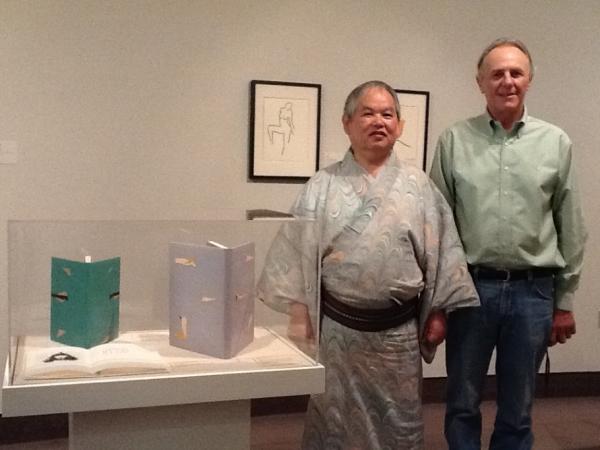Unframed’s Alex Capriotti toured the exhibition Ohie Toshio and the Perfection of the Japanese Book with artist Ohie Toshio, Dr. John Solt, and LACMA curator Hollis Goodall. Dr. Solt translated for the artist as we talked about the his process, inspiration, and how the exhibition came together. Ohie Toshio will be in the galleries throughout his the run of the exhibition to speak with visitors about his craft. Drop by on August 26, September 11, September 30, or October 9 at 2 pm to chat about the art of book design.
Alex Capriotti: How did you become interested in the art of bookbinding?
Ohie Toshio: I feel that, within books, there is a heart or mind and that’s what first moved me. I was in my teens when I saw the outside of books and felt like there was some kind of connection I was feeling from inside the books. When I read the foreword and the afterword of books I felt even more so that there was something more inside these books, something to know about.
It had been about a hundred years since the introduction of Western bookbinding in Japan. I wanted to gain an understanding of the origin of the heart [Dr. John Solt: In Japan, the words heart and mind are the same word.] of the books and so I decided to travel to France to study it at the source.
AC: Where did you study in France?
OT: I attended Ecole Superieure Estienne des Arts et Industries Graphiques, a special school which taught traditional ways of bookbinding. But I couldn’t speak French. It was difficult, but I managed to learn the process without speaking.
JS: At this school, they had two different courses. One was making a deluxe book by putting in a minimum of 200 hours into the project. The other was a course which taught how to make books in quantities of 10, 30, 50, or more. No one has ever done both courses except for him.
OT: This was a great experience for me. I was able to work with some of the best teachers and designers in bookbinding. I also loved the contents of the books. It was just amazing.
JS: For him, the whole point of what he is doing is not the covers—that’s just a part of it. The thing is the author and the content. The author has written a book and it is now his job to convey from the author to the reader the most beautiful and best way to read it and take it in—the paper the illustrations, the cover, the font—everything is part of conveying the soul of the author to the reader. The cover is a piece of that.

Ohie Toshio; Karasawa Hitoshi, The Life of Saigyo, 1995, hardcover book, collection of Ohie Toshio
AC: Did you find that you had to work to fuse Japanese and Western traditions of bookbinding?
OT: While illustrated books that stood on their own as splendid works of art have long existed in Japan, there was no history of the bound book as a luxury item as there was in France. They were mostly using cheaper ways of printing books. They were not yet exposed to the type of book I create which has a lot of thought and heart in it. Decorative bookbinding had to first be brought in line with Japanese tastes before local audiences could appreciate it. Eventually, the Japanese people began to appreciate elements of this craft like the use of deluxe Japanese papers and mosaic-onlaid leathers.
JS: He is taking the French technique of bookbinding, and then using Japanese techniques like color combinations and the use of blank space and applies those elements to his books.
AC: And did the French also have the idea of trying to capture the heart of a book in its encasing?
OT: The French don’t think that at all. They only made books for money. I’m experimenting with trying to figure out how to transmit to the next generation the idea of the heart that goes into the book, the paper, and the illustrator.





